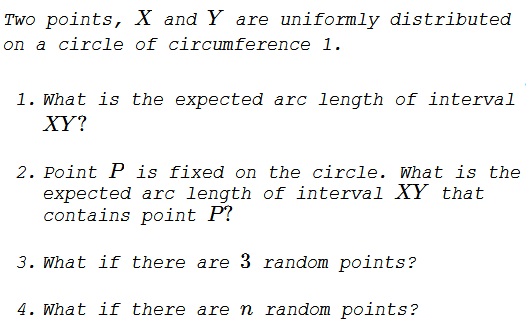Expectation of Interval Length on Circle
Problem

Solution 1
Fix a direction on the circle. If $XY$ denotes the arc length from point $X$ to point $Y$ then $XY+YX=1$ and, by symmetry, the two intervals have the same distribution. Thus the average length of either is $\displaystyle \frac{1}{2}.$
If there are three random points then, by the same token, the expected length of any of the intervals is $\displaystyle \frac{1}{3}.$ The same holds for two random points dropped onto segment $[0,1].$ Dropping $n$ points on $[0,1]$ is equivalent to dropping $(n+1)$ points onto the circle. This means that if one point is fixed on the circle, it falls into an interval which is the union of the two intervals with that point as one of the ends. It follows that $P$ belongs to the interval whose average lengths is twice that of other intervals.
Thus if there are $n$ random points, the average arc length of an interval is $\displaystyle \frac{1}{n}.$ With $n$ random points and one fixed, the expected length of the interval that contains the fixed point is $\displaystyle \frac{2}{n+1}.$
Solution 2
We are looking for $f(.)$, the PDF of the distribution of $z=\max \left(\left| x-y\right| ,\left| -x-y+1\right| \right):$
$\displaystyle f (z)=\left\{ \begin{array}{cc} 4-4 z & \frac{1}{2}\lt z\lt 1 \\ 4 z & 0\lt z\leq \frac{1}{2} \\ 0 & \text{elsewhere} \\ \end{array} \right.$
Finally
$\displaystyle \int_0^1 z f (z) \, dz=\frac{1}{2}$
Acknowledgment
This is a modified example from W. Feller's An Introduction into Probability Theory and Its Applications, v2, Ch 1 (John Wiley & Sons, Inc.; 2nd edition, 1971)
Solution 2 is by N.N.Taleb.
|Contact| |Front page| |Contents| |Probability|
Copyright © 1996-2018 Alexander Bogomolny73581268
